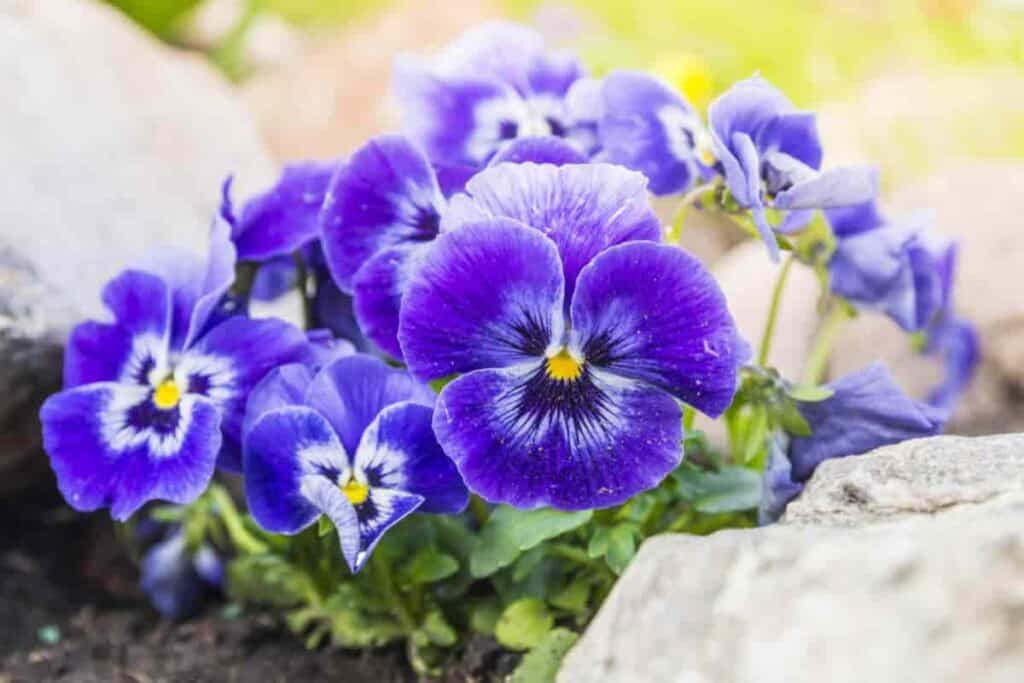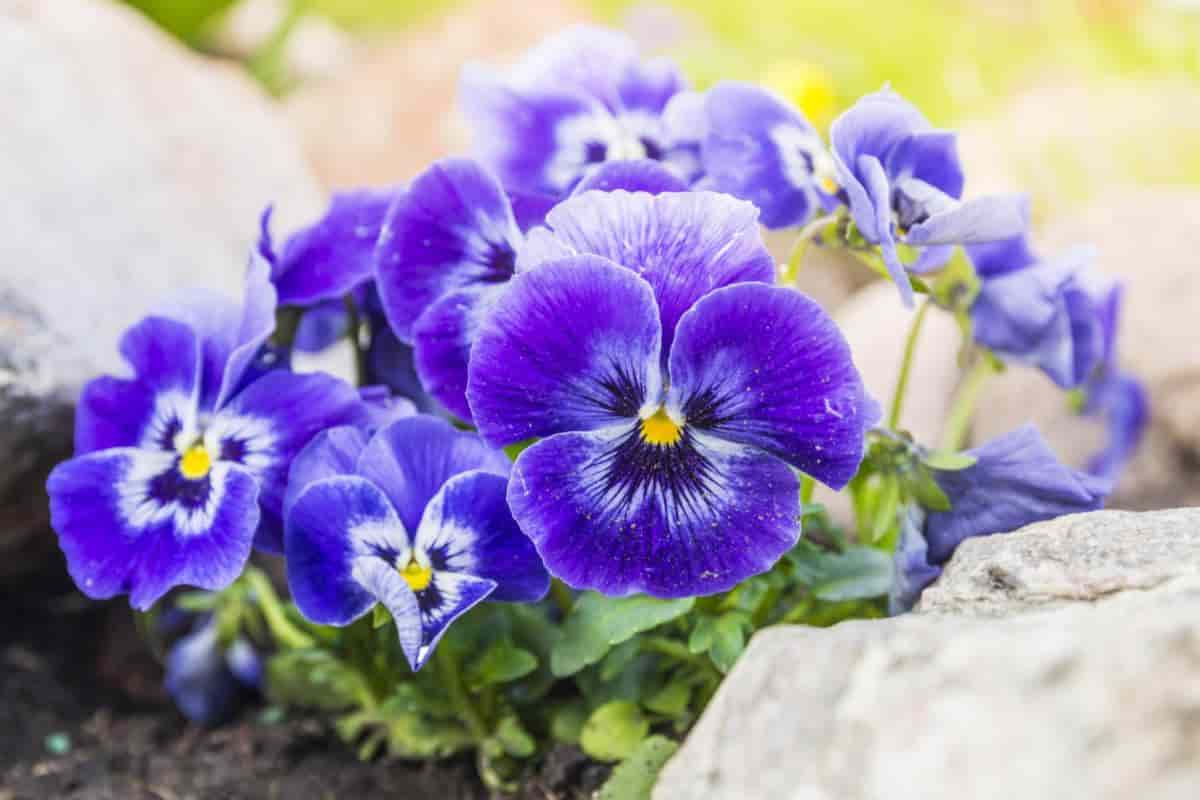The pansy is of easy culture, blossoms profusely for months, and maybe had in many colors from delicate pastel shades to rich, dark tones, some solid colors, others blotched, penciled, or veined.
There are varieties so ruffled that they appear almost double. Those with “faces” seem all the more friendly.

Fresh, new crop seed is generally available in late July and early August, which is the time to plant the seeds to ensure months of beautiful blossoms.
Growing Pansy Seeds
Seeds planted as late as early September produce plants large enough to winter over safely, but they do not bloom as soon as seeds sown earlier.
It has been stated that pansy seeds do not germinate unless the nights are cool, but I have no trouble if I prepare the seed bed frame carefully and shade the young plants during hot weather.
For one or two packets of seeds, the bottom may be knocked out of a fruit lug to provide a protected boundary for the seedbed and one that can be covered.
Or a few seeds may be planted in coffee cans (with holes in the bottoms for good drainage) or flower pots sunk into the ground.
A seed frame (very simply constructed from four boards 5” or 6” inches high, nailed or staked in place to form a rectangular bed) provides space for any number of packets.
Ideal Soil
The soil should be light and loose, of a spongy texture, and free from lumps. Heavy soil can be mixed with sand, and a generous amount of humus, such as peat or compost, can be added.
The soil should be moist to a depth of several inches. Water the bed repeatedly until the moisture has soaked down 5” or 6” inches. This is very important. Let it dry until the surface can be worked without caking.
Sowing The Seeds
The seeds may be broadcast if planted in pots, cans, or a very small frame. However, a larger area should be marked off in rows to make weeding and cultivating easier.
Press a narrow board down lightly to mark the rows, which should be four or five inches apart.
If several kinds of seeds are planted, label each row carefully. Then, plant the seeds as evenly as possible and press them into the soil.
Sprinkle a little soil over them, just enough to barely cover the seeds from sight. Water very gently but well, to settle the seeds snugly.
Open a burlap bag out flat, or use newspapers to lay over the planted bed. Cover the seed frame with a second burlap bag.
Pre-Planting Watering
If the pre-planting watering was done thoroughly and the bed watered well after planting, there should be no danger of the soil drying out if it is kept carefully covered, but it is advisable to examine the planting of every clay to see that all is well.
It would be fatal to let the bed dry out even once during germination. The two main reasons for pansy seed-planting failures are planting too deep and permitting the seed bed to dry out during the critical germination period.
If the weather should turn very hot during this time, it makes for cooler temperatures to sprinkle the burlap bags several times each day.
Germinating Pansy Seeds
Ten days are usually given as the time it takes for pansy seeds to germinate, but under very favorable conditions, the most energetic seeds may be up in six days. It will take 11 or 12 days for the lazy ones.
The lower cover directly over the seeds must be removed as soon as there an; any signs of germination, or the little plants will grow right through the burlap and be pulled up when the cover is lifted. The cover on the frame is left on until the plants are all up and growing well.
Then it is removed at night and on cloudy days. The young plants should have protection on windy days, or when the sun’s rays are hot, but when cooler weather arrives, the upper cover is left off permanently.
Planting Pansies
Thin the plants to stand 3″ or 4″ inches apart when they get their fourth leaf. The soil must be kept nicely moist but never soggy wet for any time.
Let the surface dry between waterings. Keep the weeds pulled and occasionally cultivate between the rows.
The plants may remain in the seed frame until spring or be moved to their permanent places in late September or early October.
They should be in a sunny location for the best fall growth and early spring blossoms.
The north side of a foundation is too shady at any time unless they are set far enough out to get several hours of morning and afternoon sun. A cast location in the morning sun is ideal.
Wherever they are set, they should have soft, spongy soil where the mass of fragile, white thread-like roots can crawl and grow unhampered.
Winter Preparation
Pansies require moist conditions until the ground freezes. Dried leaves or half-rotted straws can be placed around and under the plants to conserve moisture, keep the soil cool, and prevent the ground from heaving.
In December, a light, loose covering of evergreen branches, asparagus, zinnia, or tomato tops are placed over the pansies.
Because the plants remain green all winter, one must avoid any top covering that would pack down or smother the plants.
If the seeds were planted early and the season favorable, the plants will be budded and even bloom when winter comes.
They winter over easily and will be among the first plants to show growth and blossom in late March.
Growing Pansies
When I first began to grow pansies, I was told that it was necessary to keep every blossom picked, or the plants would cease to bloom.
It is true that the more I picked, the more they bloomed, but the blossoms became smaller and smaller on shorter and shorter stems.
Every available container, from small vases and odd jars to sugar bowls and cream pitchers, was crowded with pansy blossoms, but no one could say they were lovely.
In time I learned if the blossoms were not picked, they became larger by the third or fourth day after opening. I discovered that it was only necessary to remove the FADED blossoms to prevent seed formation.
The plants continued to bloom with this treatment—they were a joy to behold. Then, when flowers were wanted for the house, the blossoms were cut with stems long enough to include plenty of foliage.
A few such stems arranged loosely on a pin holder in a low container are truly lovely. Cutting part of the foliage has the same effect as pruning and promotes new growth with more buds and flowers.
Pansy Varieties
Pansy specialists delight us with such varieties as the following:
- ‘Ullswater,’ a charming blue with black blotch:
- ‘Blue Knight’
- ‘Moon Moth,’ a good big white
- ‘Mont Blanc,’ somewhat smaller but a fine white
- ‘Pay Dirt,’ a ruffled yellow
- ‘Coronation Gold’ and “Ruby Velvet,’ red and occasionally copper tones
- ‘Alpenglow,’ a rich, velvety red
- ‘Raspberry Rose,’ one of the delightful new colors, besides all sorts of pleasing mixtures of hybrids, will give a thrilling show for any gardener.
Blooming Pansies In May
If you have been buying a basket of pansies in full bloom in May, you are cheating yourself out of months of delightful blossoms.
You will be amazed at what you have missed by not planting your selection of pansy seeds in August.
44659 by Olga Rolf Tiemann
